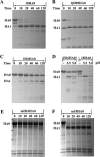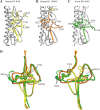Insights into avian influenza virus pathogenicity: the hemagglutinin precursor HA0 of subtype H16 has an alpha-helix structure in its cleavage site with inefficient HA1/HA2 cleavage
- PMID: 22993148
- PMCID: PMC3497694
- DOI: 10.1128/JVI.01606-12
Insights into avian influenza virus pathogenicity: the hemagglutinin precursor HA0 of subtype H16 has an alpha-helix structure in its cleavage site with inefficient HA1/HA2 cleavage
Abstract
With a new serotype (H17) of hemagglutinin (HA) recently being discovered, there are now 17 serotypes (H1 to H17) of influenza A viruses in total. It is believed that HA is initially expressed as a precursor of HA0 and then cleaved into HA1 and HA2, forming a disulfide bond-linked complex, for its full function. Structural data show that a loop structure exists in the cleavage site between HA1 and HA2, and this flexible loop is crucial for the efficient cleavage of HA0. Here, the crystal structures of H16 (a low-pathogenicity avian influenza virus) in their HA0 form (H16HA0) have been solved at 1.7-Å and 2.0-Å resolutions. To our surprise, an α-helix element in the cleavage site which inserts into the negatively charged cavity with the key residue R329 hidden behind the helix was observed. In vitro trypsin cleavage experiments demonstrated inefficient cleavage of H16HA0 under both neutral and low-pH conditions. The results provide new insights into influenza A virus pathogenicity; both the relatively stable α-helix structure in the flexible cleavage loop and inaccessibility of the cleavage site likely contribute to the low pathogenicity of avian influenza A virus. Furthermore, compared to all of the HAs whose structures have been solved, H16 is a good reference for assigning the HA subtypes into two groups on the basis of the three-dimensional structure, which is consistent with the phylogenetic grouping. We conclude that in light of the current H16HA0 structure, the natural α-helix element might provide a new opportunity for influenza virus inhibitor design.
Figures







Similar articles
-
Intermonomer Interactions in Hemagglutinin Subunits HA1 and HA2 Affecting Hemagglutinin Stability and Influenza Virus Infectivity.J Virol. 2015 Oct;89(20):10602-11. doi: 10.1128/JVI.00939-15. Epub 2015 Aug 12. J Virol. 2015. PMID: 26269180 Free PMC article.
-
The uncleaved viral hemagglutinin HA0 increases influenza A virus resistance to thermal pasteurization.Virology. 2025 Mar;604:110389. doi: 10.1016/j.virol.2025.110389. Epub 2025 Jan 3. Virology. 2025. PMID: 39889479 Review.
-
Cleavage of influenza a virus hemagglutinin in human respiratory epithelium is cell associated and sensitive to exogenous antiproteases.J Virol. 2002 Sep;76(17):8682-9. doi: 10.1128/jvi.76.17.8682-8689.2002. J Virol. 2002. PMID: 12163588 Free PMC article.
-
Glycosylation at hemagglutinin Asn-167 protects the H6N1 avian influenza virus from tryptic cleavage at Arg-201 and maintains the viral infectivity.Virus Res. 2015 Feb 2;197:101-7. doi: 10.1016/j.virusres.2014.12.010. Epub 2014 Dec 17. Virus Res. 2015. PMID: 25527464
-
Role of hemagglutinin cleavage for the pathogenicity of influenza virus.Virology. 1999 May 25;258(1):1-20. doi: 10.1006/viro.1999.9716. Virology. 1999. PMID: 10329563 Review.
Cited by
-
Structure and receptor binding specificity of hemagglutinin H13 from avian influenza A virus H13N6.J Virol. 2013 Aug;87(16):9077-85. doi: 10.1128/JVI.00235-13. Epub 2013 Jun 12. J Virol. 2013. PMID: 23760233 Free PMC article.
-
Isolation and Characterization of H1 Subtype Swine Influenza Viruses Recently Circulating in China.Viruses. 2025 Jan 27;17(2):185. doi: 10.3390/v17020185. Viruses. 2025. PMID: 40006940 Free PMC article.
-
Hemagglutinin homologue from H17N10 bat influenza virus exhibits divergent receptor-binding and pH-dependent fusion activities.Proc Natl Acad Sci U S A. 2013 Jan 22;110(4):1458-63. doi: 10.1073/pnas.1218509110. Epub 2013 Jan 7. Proc Natl Acad Sci U S A. 2013. PMID: 23297216 Free PMC article.
-
Structure and receptor-binding properties of an airborne transmissible avian influenza A virus hemagglutinin H5 (VN1203mut).Protein Cell. 2013 Jul;4(7):502-11. doi: 10.1007/s13238-013-3906-z. Epub 2013 Jun 20. Protein Cell. 2013. PMID: 23794001 Free PMC article.
-
Advancements in Host-Based Interventions for Influenza Treatment.Front Immunol. 2018 Jul 10;9:1547. doi: 10.3389/fimmu.2018.01547. eCollection 2018. Front Immunol. 2018. PMID: 30042762 Free PMC article. Review.
References
-
- Anonymous 1994. The CCP4 suite: programs for protein crystallography. Acta Crystallogr. D Biol. Crystallogr. 50:760–763 - PubMed
-
- Bullough PA, Hughson FM, Skehel JJ, Wiley DC. 1994. Structure of influenza haemagglutinin at the pH of membrane fusion. Nature 371:37–43 - PubMed
-
- Chen J, et al. 1998. Structure of the hemagglutinin precursor cleavage site, a determinant of influenza pathogenicity and the origin of the labile conformation. Cell 95:409–417 - PubMed
-
- Corti D, et al. 2011. A neutralizing antibody selected from plasma cells that binds to group 1 and group 2 influenza A hemagglutinins. Science 333:850–856 - PubMed
Publication types
MeSH terms
Substances
LinkOut - more resources
Full Text Sources
Other Literature Sources
Research Materials
Miscellaneous

